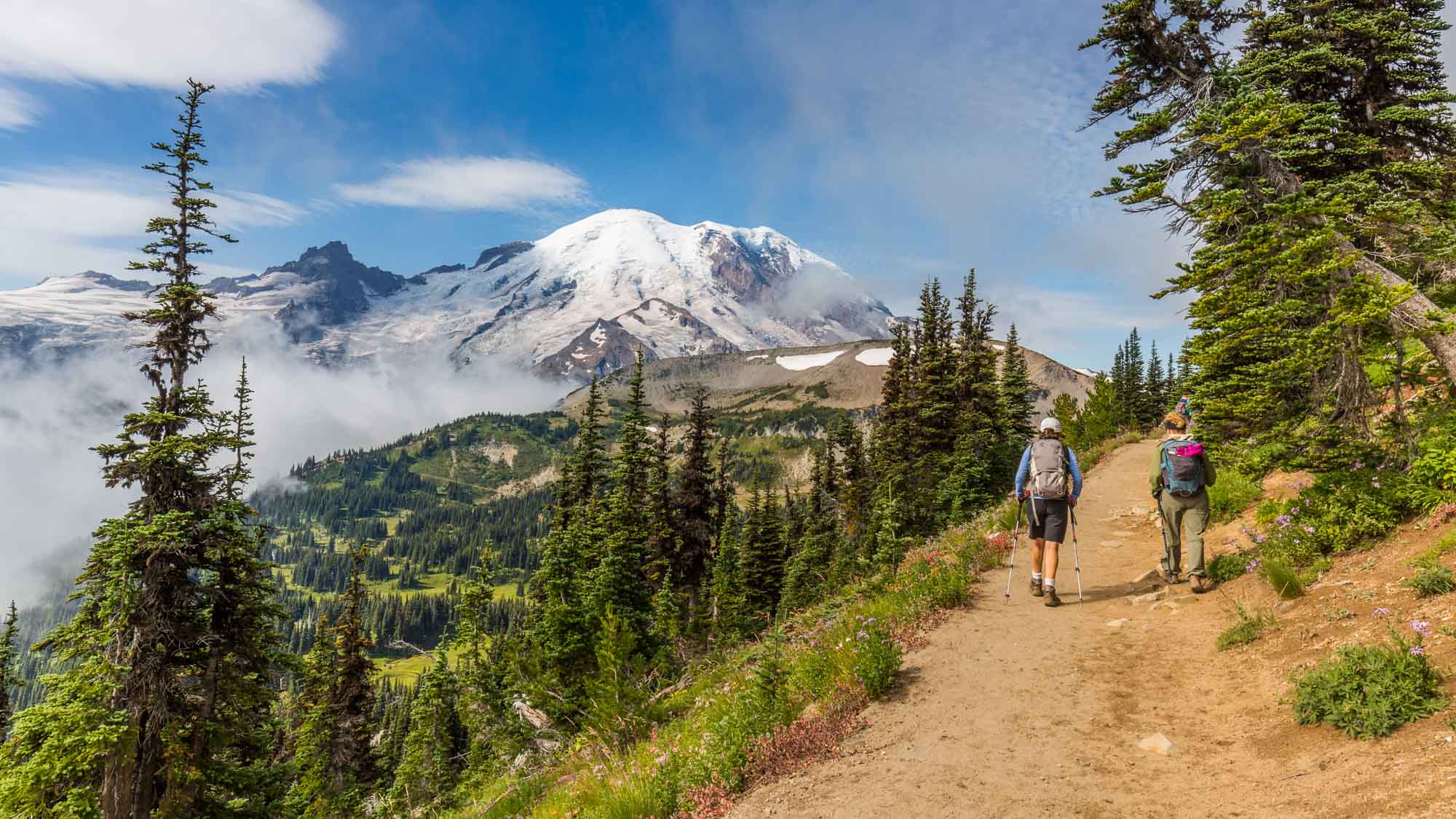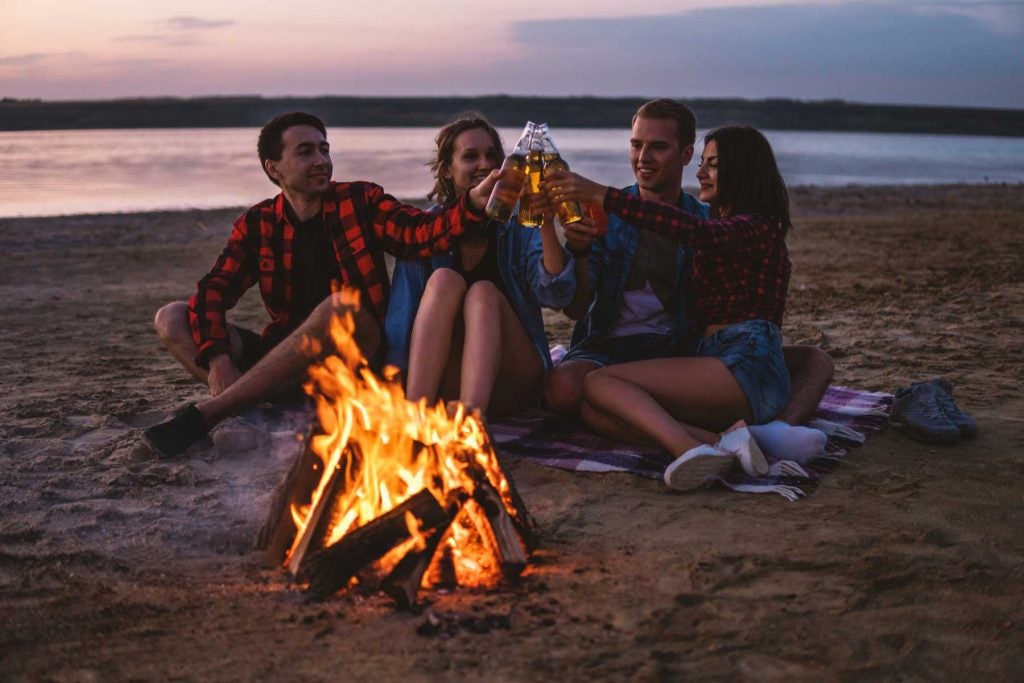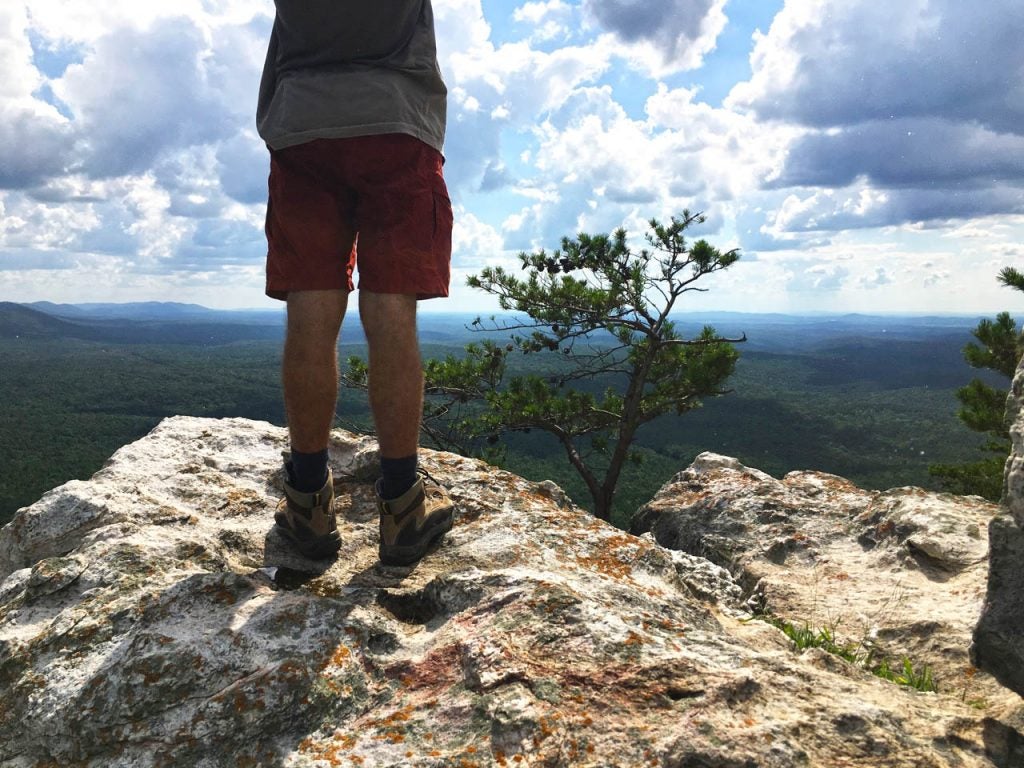Dominating the landscape in central Washington, and visible from just about any high point in the state, Mount Rainier is the tallest volcanic peak in the Pacific Northwest. Reaching a sky-scraping elevation of 14,411 feet, Mount Rainer is shrouded with 25 named glaciers that cover more than 35 square miles of the mountain’s rugged flanks. Emanating from these glaciers are dozens of rivers, streams and waterfalls that nourish sprawling meadows of summer wildflowers, and cascade down the mountain’s lower, forested slopes.
Protecting this volcanic alpine wonderland is Mount Rainier National Park (MRNP). Covering an area of more than 230,000 acres on and around the mountain, it was dedicated in 1899 as America’s 5th national park. This was done with the urging of famed wanderer and conservationist John Muir. Each year, MRNP receives upwards of two million visitors who flock to the mountain’s viewpoints, campgrounds and hiking trails. Most of these only come for a day or two, and experience only a fraction of the mountain’s true majesty. For those with the time and the adventurous inclination, there’s only one way to experience all of Mount Rainier’s grandeur and beauty: hiking the Wonderland Trail.
Hike Mount Rainier’s Wonderland Trail
The Wonderland is MRNP’s epic, 93-mile hiking trail that circuits the entire mountain. This rugged and strenuous trail climbs over volcanic ridges, dives through glacial valleys, traverses sprawling alpine meadows, and wanders through temperate rain forests. It takes most hikers more than a week to complete the loop. Days are spent soaking up one amazing mountain view after another, and nights are spent in remote backcountry campsites, resting up for the next day on trail. In this way, hikers can experience Mount Rainier from literally every angle—almost to the point of scenic overload.
Hiking the Wonderland is not just a walk in the park. With more than 22,000 feet of cumulative elevation gain (more than 4 vertical miles!), it is extremely strenuous. During the course of the trek around the mountain, hikers will have to ascend numerous high, volcanic ridges, which radiate out from the mountain’s summit. Typically, these are followed by descents into deep river valleys. This results in a repetitive, roller coaster-like journey of steep ups and downs—again and again, day after day. If you’re up for the challenge, then the Wonderland Trail is waiting for you.
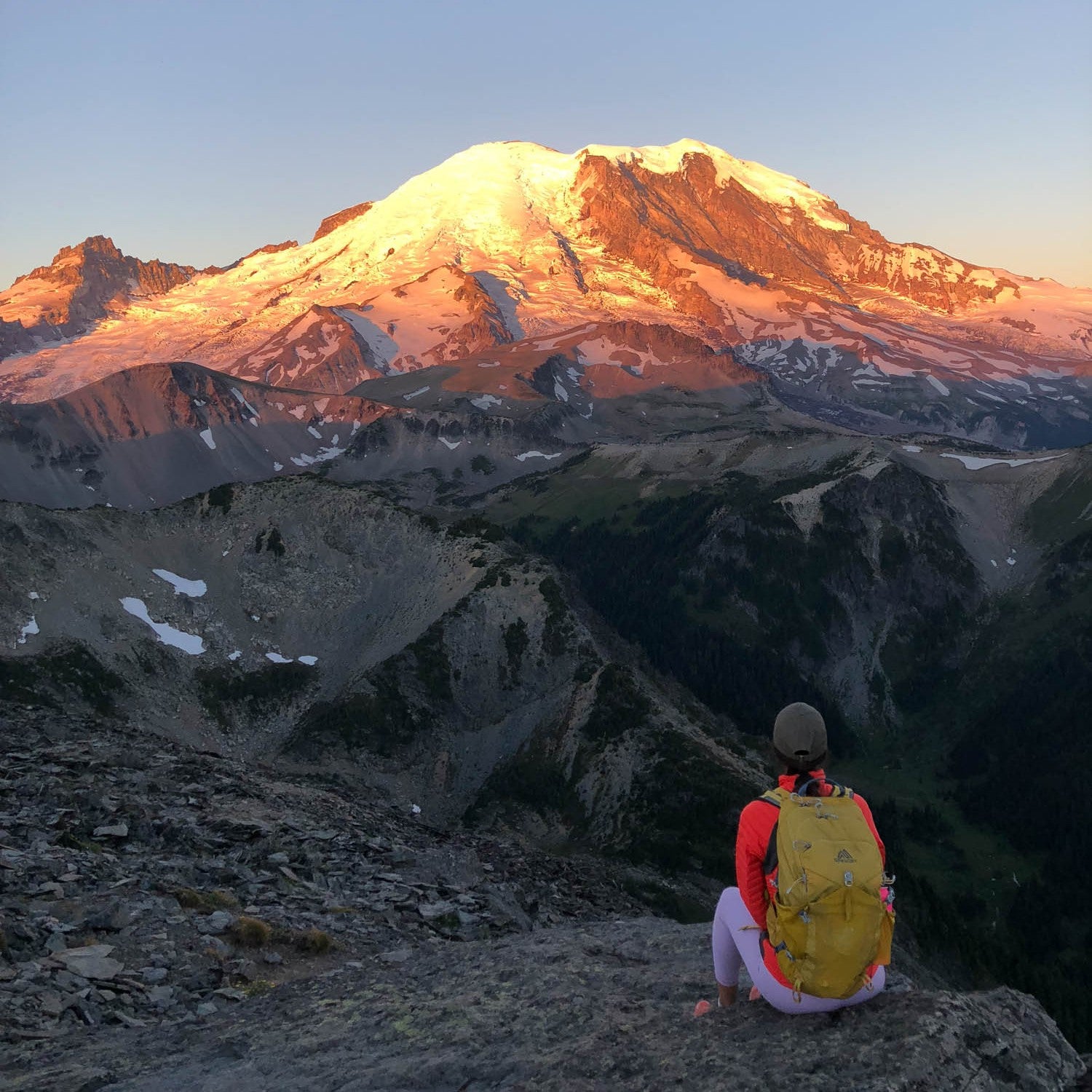
Image from The Dyrt camper Sasha W.
When to Hike the Wonderland Trail
Mount Rainier has a remarkably short hiking season, typically from mid-July until mid-September. This small window of opportunity is between one winter’s snowmelt and the next winter’s snowfall, and is when the trail is mostly dry and snow-free. This is also when the Northwest weather is at its warmest, and precipitation minimal. In recent years however, dramatic variations in weather and climate have resulted in widely variable, longer and shorter hiking seasons.
For Wonderland hikers, this factor is more important than for many other hikers. This is because some remote sections of the trail—such as 6,800-foot Panhandle Gap—reach higher elevations than many other trails on the mountain. It’s not uncommon for these high passes to remain covered in snow well into—or through—the summer months. And even in summer months, mountain weather can be fickle. Before beginning your Wonderland hike, be sure to check the current weather and trail conditions so you can be adequately prepared for your adventure, or make adjustments if necessary.
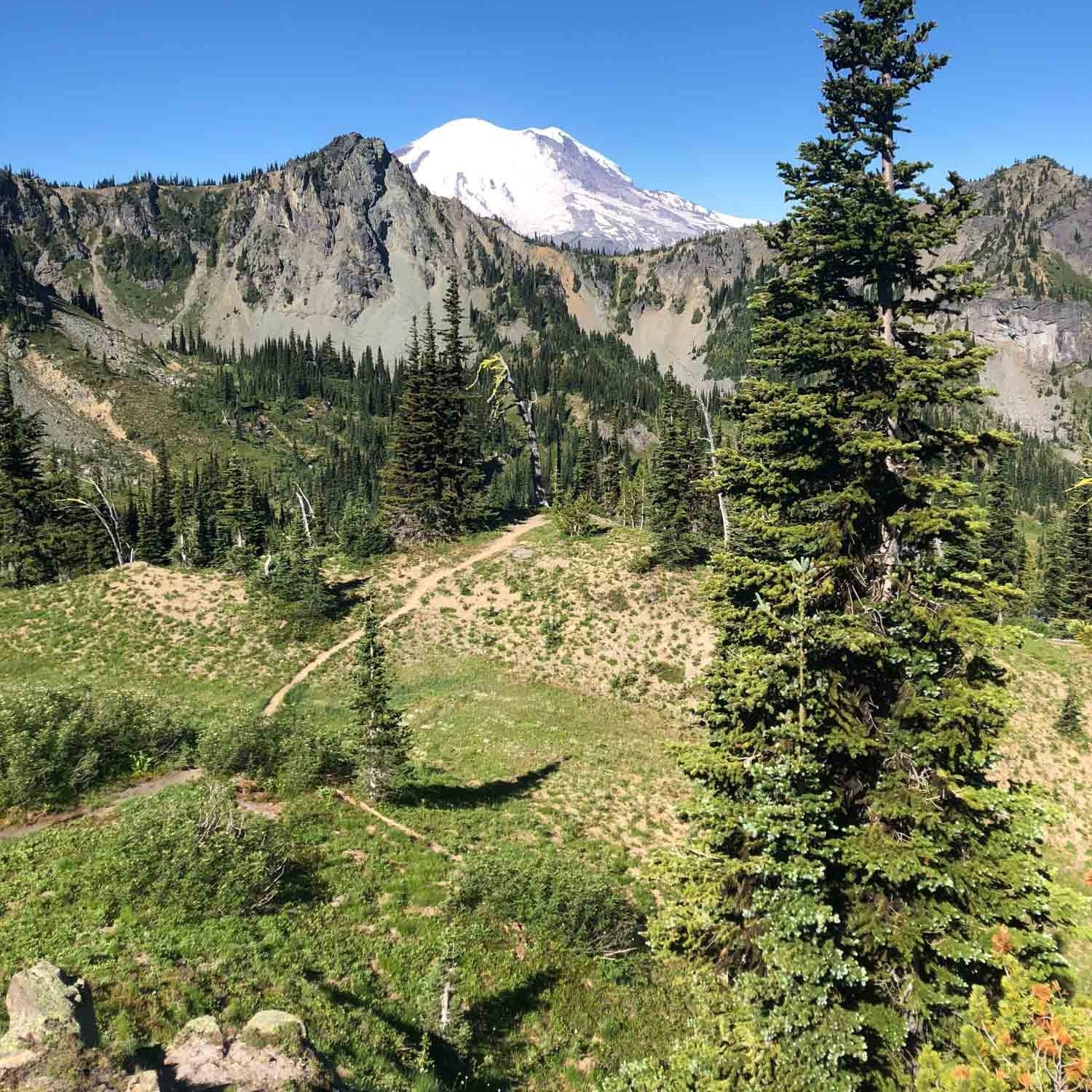
Image from The Dyrt camper Sasha W.
Wilderness Camping Permits
Overnight camping on the Wonderland Trail requires a backcountry wilderness permit. These are only available through the park’s wilderness office. The park makes 70% of backcountry wilderness permits available through their reservation process in the spring. The remaining 30% of permits are held for walk-up, first-come, first-serve hikers. Because Wonderland Trail hiking has become increasingly popular in recent years, with permits requests in high demand, the park recommends that hikers submit permit reservation requests well in advance (see How to Apply).
Submitting your backcountry permit request can be tricky, and requires some planning. Unlike many national parks that let you wander and camp at will in the backcountry, MRNP requires Wonderland you to identify each night and camp location that you plan on spending on the mountain. The best way to do this is with their wilderness trip planner. Having a little bit flexibility with your start day, trailhead and choice of campsites can be beneficial to securing a permit. If you’re more inclined to just wing it, you can show up at one of the park’s Wilderness Information Centers (WIC) and see what’s left.

Image from The Dyrt camper Kyle M.
How to Apply for your Wonderland Trail Wilderness Permit
- MRNP starts accepting wilderness permit applications on March 15.
- The park begins processing permit applications on April 1.
- Permit applications cost $20 per party (up to 12 people). This fee is non-refundable, regardless of whether or not you actually get a permit.
- It may take from 2 to 6 weeks to receive notice if you are granted a permit.
- In recent years, due to high volumes of permit requests, the park has stopped accepting applications after April 1, so get yours in early!
Pro Tip: “If you don’t get a permit reservation, you can still get a first-come, first-served permit. You can increase your odds of getting what you want by arriving at the ranger station at 6:30 am, the day before you hope to depart. The ranger stations open at 7:30 am, so plan to arrive early to be at the front of the line.” —Tami Asars, author of Hiking the Wonderland Trail
When You Receive Your Wonderland Trail Wilderness Permit
- Your permit reservation grants you one full-circuit Wonderland Trail trip.
- Permits are valid for up to 14 consecutive nights, i.e., you have 2 weeks to complete your hike.
- You must pick up your actual permit at a WMRNP WIC by 1oam on the day your hike starts; you may also pick it up the day before.
- If you do not pick up your permit by 10am, or notify the park ahead of time about a delay, you will forfeit your permit, and it becomes available to walk-up hikers.
- You are required to camp at the campsites indicated on your wilderness permit.
Starting Your Wonderland Journey
There are three main trailheads used for launching Wonderland Trail hikes. These are spaced roughly in thirds around the mountain. The most popular trailhead is near Longmire. This small village is accessible via the park’s southwest Nisqually entrance. This is the park’s busiest entrance due to it’s proximity to Puget Sound and major highways to the west. The village has an inn, restaurant, museum, picnic area, and a Wilderness Information Center (ranger station) where you can pick up your permit. The Cougar Rock Campground is just a few miles east of here.
On the opposite, northeast, side of the mountain, Sunrise is another key location for starting Wonderland Trail hikes. This is the entrance most Seattleites use when visiting MRNP, and is the highest place in the park accessible by vehicle—thus, a popular destination for day-use visitors. This location has a visitor center and day lodge with food service. The White River Campground is located in the valley just below Sunrise, and is a close-by alternative launch point. If starting in this area, permits must be picked up at the White River WIC entrance station. For late-season hikes, be aware that the services at Sunrise often close after Labor Day.
The third—and lesser-used—location for kicking off Wonderland Trail hikes is Mowich Lake. The road to this location is unpaved and not well-maintained, so the drive in can be rough. The campground is pretty lackluster, with just vault toilets and a patrol cabin. Despite that, it has direct access to the Wonderland Trail, as well as pretty blue Mowich Lake, the deepest body of water on the mountain. Permits to start at Mowich Lake can be picked up at the Carbon River ranger station. Hikes can also be started at the Box Canyon trailhead on the southeast side, near the Stevens Canyon entrance, and the Ipsut Creek trailhead on the northwest side, at the end of the Carbon River Road.
Camping on the Wonderland Trail
There are more than 20 campgrounds for pitching your tent on your 93-mile Wonderland Trail journey. Most of these are small, wilderness camp areas near the trail that can accommodate from two to eight hikers. Many of these also have at least one group site that can accommodate up to 12 hikers. These limits are important to know when you’re planning your hike and submitting your permit reservation form. Camp areas with fewer sites can be harder to get, or could limit the number of people in your hiking group.
In addition to the backcountry camp areas, there are also three frontcountry campgrounds on or near the Wonderland Trail. These are conveniently located about equal distances around the mountain: Cougar Rock on the south side, Mowich Lake on the northwest side, and White River on the northeast side. These can give you an opportunity to have access to a few conveniences such as picnic tables, toilets and trash receptacles. Camping at Cougar Rock during your journey, requires reserving a site in advance; the other two campgrounds are first-come, first-served.
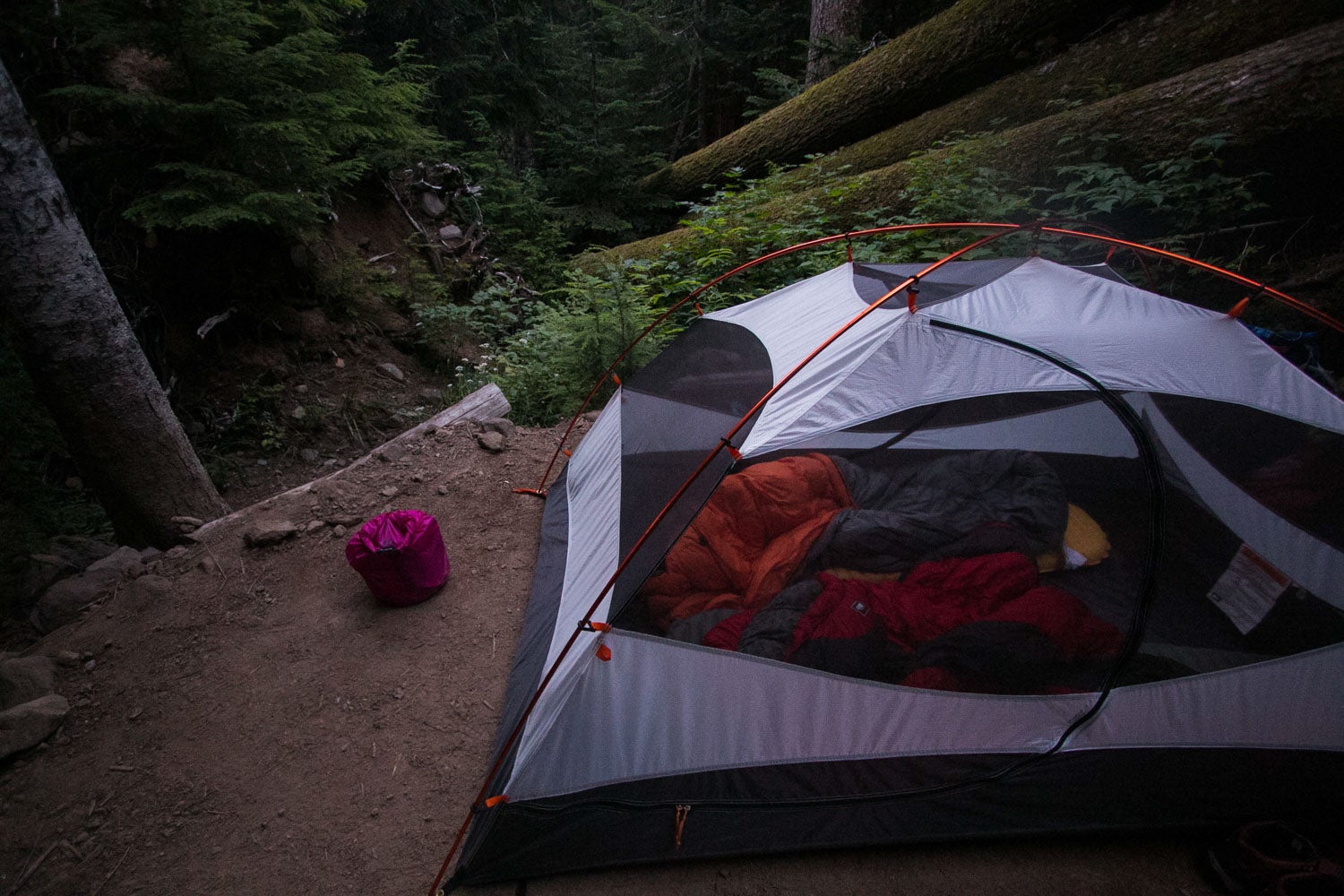
Image from The Dyrt camper Danielle S.
Wilderness Camping on Mount Rainier
In order to keep human impacts and environmental damage in the wilderness to a minimum, MRNP has designated 18 wilderness campgrounds along the Wonderland Trail. These are spread out at various distances, with most being less than a day’s hike away from the next. This is one of the great joys of hiking the Wonderland, as it helps disperse crowds along the trail for a more enjoyable backcountry experience. Some of the larger, more popular camps include Devil’s Dream, Mystic Camp, and Summerland, which are nice for hiking in groups, or making friends on trail. Conversely, the smaller camps at Granite Creek, Klapatche Park, and Nickel Creek offer more quiet and solitude.
Pro Tip: “Summerland, Indian Bar and Klapatche Park are the most scenic wilderness camps along the trail, yet these can be challenging to get. If you’re relegated to a forested camp, you can take your time on the trail. Your permit reserves your campsite for you. This way, you can enjoy your dinner trailside, with glorious mountain views, then head to camp.” —Tami Asars, author of Hiking the Wonderland Trail
In order to maintain Mount Rainier’s natural wilderness character, and preserve its sensitive alpine environments, Wonderland Trail campers should exercise Leave No Trace practices. This means pitching tents on durable surfaces in designated camp areas, packing out all trash and waste material, and being considerate of other hikers. All backcountry campsites are equipped with wilderness privies and food storage poles (see Managing Your Food and Water). If you need to dig a cathole or dump waste water, it should be done at least 200 feet from the trail, campsites and water sources.

Image courtesy of Tami Asars, author of Hiking the Wonderland Trail
Managing Your Food and Water
With just two exceptions—Longmire and Sunrise—the entire Wonderland Trail stays in the Mount Rainier backcountry—and you need to eat. That means you need to carry all the food you’ll need to get you around the mountain. This could be up to two weeks’ worth of breakfasts, lunches, dinners, snacks, and treats. You have two options: tough it up and carry it all from the start (not recommended), or cache food around the mountain and pick it up as you hike (recommended).
Caching Food on Mount Rainier
In order to minimize your food load, you can conveniently cache (store) food at four locations around the mountain. This allows you to carry less food weight in your backpack and have a more enjoyable hiking experience. All of these caches are just steps off the trail, so you don’t need to deviate far to pick up your next load. You can store food at these locations:
- Wilderness Information Center at Longmire
- Patrol Cabin at Mowich Lake
- Old Gas Station at Sunrise
- White River Campground
The easiest way to cache your food is to simply drop it off at the locations you plan to use, prior to starting your hike. You will find marked food cache bins to deposit your package. Packages must be stored in a plastic container (bucket with lid), and must be labeled with the name of the wilderness permit holder, pick-up date (estimated), and permit number (if known). If you are caching stove fuel, there is a separate bin to use.
Alternatively, you can mail your food caches to MRNP. The recommended method is via UPS or FedEx, at least two weeks in advance of your estimated pick-up date. If sending caches to the Sunrise or White River locations, your package must be marked accordingly. These will be deposited by the White River WIC. Stove fuel cannot be mailed and must be hand-delivered. For more information about food caching, locations, requirements and mailing info, visit the park’s website.
Storing Your Food on Trail
MRNP is home to all manner of hungry animals that would be more than happy to share your trail mix and peanut butter sandwiches with you. However, human food can be hazardous to animals, and sharing food with animals can condition them to becoming aggressive. When you’re taking breaks on the trail, you should always have your food within arms’ reach. When in camp, use the provided food storage poles and lockers to hang or secure your food overnight. Never sleep with your food in your tent overnight, or you may wake up with a furry companion munching in your food bag. This is a quick way to end your trip.
Drinking Water on Mount Rainier
When it comes to staying hydrated, there are numerous natural water sources along the Wonderland Trail. These are in the form of countless springs, creeks, rivers and waterfalls, all streaming off the mountain’s melting snow. And oh how tasty it is! Yet just because water is clear doesn’t necessarily mean it’s clean. There’s nasty bacteria in mountain water (Giardia, Crytosporidium, E. coli, etc.) that may induce gut-wrenching misery and bring your hike to a quick and unfortunate end. Thus, it is important that you filter all the water you’re going to drink. The common ways to do this are with pump filters, purification supplements, or UV devices. Better to be safe than sick!
It’s also wise to be judicious about the water you choose to collect. Many of Mount Rainier’s big rivers are glacial in origin and flow down through wide valleys of volcanic sediment. This is what gives these rivers their white, or milky, appearance. This suspended sediment, containing high amounts of silica (glass) can be harmful on both water filters and stomachs. It is best to collect and filter water from smaller water sources running clean and clear.
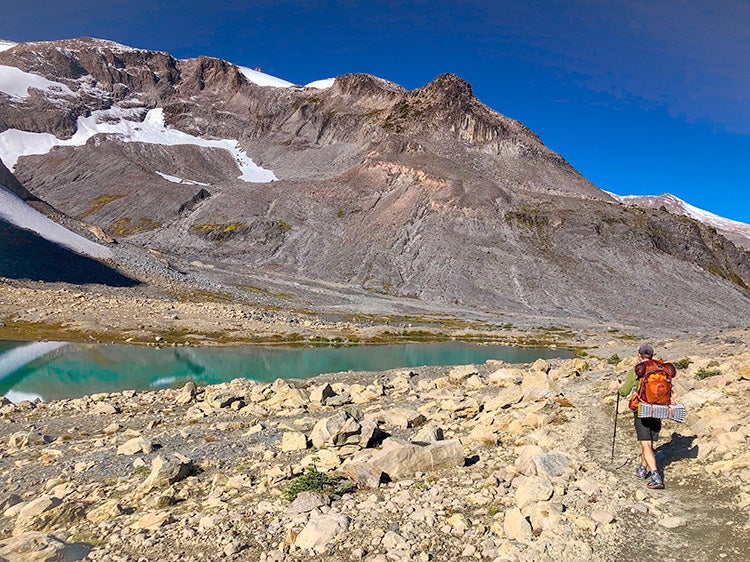
Image courtesy of Tami Asars, author of Hiking the Wonderland Trail
Safety on the Wonderland Trail
Hiking the Wonderland Trail is not a dangerous activity. Hundreds of people do it every year without incident. However, is good to remember that the Wonderland traverses a rugged wilderness environment, with all its inherent risks and dangers. If you’re going to venture into this land of flowing ice and ragged rock, mountain meadows and whistling marmots, it’s best to be prepared to handle a variety of situations, err on the side of caution, and pack along some good, common sense.
Pack Your Ten Essentials
The Ten Essentials are the basic equipment every hiker should carry when venturing into the wilderness, whether on a day hike or a long-distance backpack. These items will protect you from the sun and cold, repair busted gear or busted blisters, or get you out of an unexpected fix in the woods. Even if you use a hiking app on your smartphone, it’s still a good idea to carry a good, ol’ fashioned map and compass; even if the weather forecast says sunny, don’t leave your rain fly and jacket behind. You never know when nature, karma or the Force may throw a curveball.
Exercise Smart Water Crossings
All of the major rivers and creeks you’ll encounter on the Wonderland Trail are bridged for easy crossing. But occasionally some of these bridges get washed out, and you will need to evaluate the safety of crossing. If the water is high, fast and you can’t see the bottom, it’s probably wise to turn around and not risk it. If the river looks manageable (wide, flat water), keep your boots on, unbuckle your pack’s waist belt and cross facing upstream. You may need to scout up- or downriver to find a safe crossing. Use caution when crossing on logs and rocks, as these may not be secure.
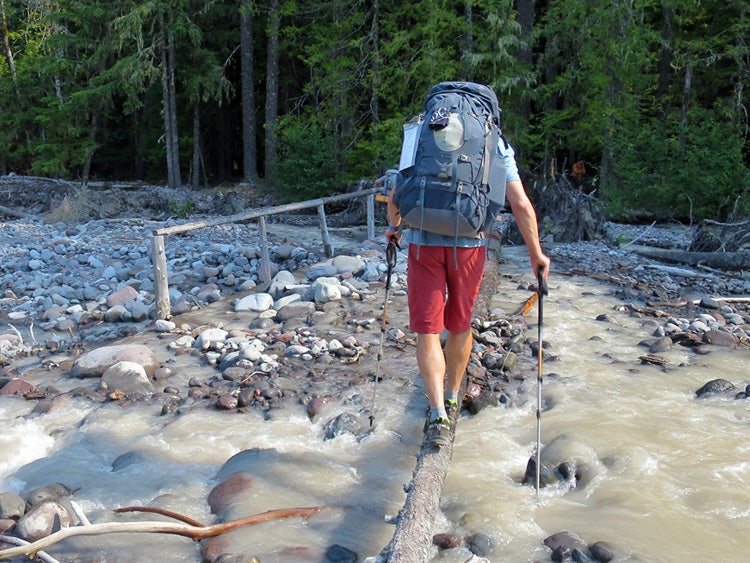
Image courtesy of Tami Asars, author of Hiking the Wonderland Trail.
Be Prepared to Encounter Wildlife
When you hike the Wonderland Trail, you are the guest of all the wildlife that call the mountain their home. The majority of these are cute, little critters that are mostly curious about your trail mix: chipmunks, pikas, squirrels, and marmots. There’s also a good chance you’ll see deer and elk in the forests and meadows, and mountain goats in the higher, rockier areas. You may also encounter black bears (there are no grizzlies in MRNP). It’s extremely rare to see cougars and wolverines in the park. Learn more about what to do if, and when, you encounter wildlife on the trail.
Have a Wonderful Wonderland Hike
Hiking the Mount Rainier’s Wonderland Trail is often a once-in-a-lifetime adventure for most hikers. It is an amazing journey through some of Washington’s most spectacular mountain scenery, and gives visitors the opportunity to fully immerse themselves in a wilderness environment where each day is measured by every view-packed turn on the trail. It is a challenge, to be sure, but one that will create memories, and inspire stories, for years to come.

